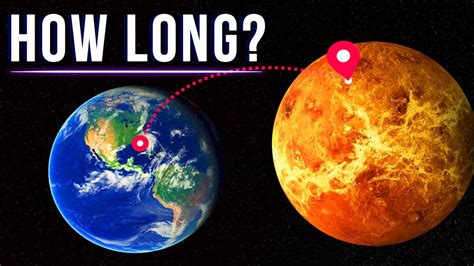How Long Does It Take To Get To The Venus
listenit
Apr 02, 2025 · 4 min read

Table of Contents
How Long Does It Take to Get to Venus? A Journey Through Time and Space
The question, "How long does it take to get to Venus?" doesn't have a simple answer. The travel time to our closest planetary neighbor is heavily dependent on several factors, including the launch window, the chosen trajectory, and the capabilities of the spacecraft. Let's delve into the complexities of interplanetary travel and explore the various factors influencing journey duration to Venus.
Understanding the Orbital Dance: Earth and Venus
Before discussing travel times, it's crucial to understand the orbital mechanics of Earth and Venus. Both planets orbit the Sun, but at different speeds and distances. Earth completes one orbit approximately every 365 days, while Venus takes about 225 days. This difference in orbital periods means that the relative positions of Earth and Venus are constantly changing.
Optimal Launch Windows: The Key to Efficiency
Space agencies meticulously plan missions to take advantage of optimal launch windows. These windows occur when Earth and Venus are in the most favorable positions for a fuel-efficient journey. Launching during these periods minimizes the travel time and fuel consumption, making the mission more feasible and cost-effective.
Hohmann Transfer Orbit: The Efficient Path
A common trajectory used for interplanetary travel is the Hohmann transfer orbit. This is an elliptical orbit that tangentially intersects both the Earth's and Venus's orbits. By carefully timing the launch, a spacecraft can enter this orbit, requiring only two engine burns – one to enter the transfer orbit and another to match Venus's orbital velocity upon arrival. This method represents a fuel-efficient approach, though it results in longer travel times.
Calculating Travel Time: A Complex Equation
The travel time isn't simply a matter of calculating the distance between Earth and Venus and dividing it by the spacecraft's speed. Several factors significantly influence the journey's length:
-
Distance: The distance between Earth and Venus varies constantly due to their orbital movements. At their closest approach, they can be approximately 38 million kilometers apart, while at their farthest, the distance can exceed 261 million kilometers. This variability directly impacts the travel time.
-
Spacecraft Velocity: The speed at which the spacecraft travels is determined by its propulsion system. Faster spacecraft, such as those utilizing advanced propulsion technologies (which are still largely theoretical), would naturally reach Venus more quickly. However, current technology largely relies on chemical rockets, limiting maximum velocity.
-
Trajectory Selection: The chosen trajectory significantly affects travel time. A direct trajectory, while potentially faster, often requires more fuel. A Hohmann transfer orbit, as previously mentioned, prioritizes fuel efficiency over speed. Other, more complex trajectories might be employed to leverage gravitational assists from other planets, further impacting travel time.
-
Mission Objectives: The scientific objectives of the mission can influence the trajectory and, consequently, the travel time. Some missions might prioritize a slower, more fuel-efficient approach, while others may necessitate a quicker arrival to meet specific observation windows.
Historical Missions and Their Travel Times
Examining past missions to Venus provides valuable insight into the typical travel times. Here are a few examples:
-
Mariner 2 (1962): This NASA mission took approximately 105 days to reach Venus.
-
Venera 7 (1970): The Soviet mission, Venera 7, took approximately 126 days.
-
Magellan (1989): This NASA mission to map the surface of Venus took about 153 days.
-
Venus Express (2005): The European Space Agency's mission reached Venus in about 153 days.
These variations in travel time reflect differences in launch windows, trajectory selection, and technological capabilities at the time of each mission.
The Future of Venus Missions and Travel Time Reduction
Ongoing research and development in spacecraft propulsion systems hold the potential to significantly reduce travel times to Venus. Advanced technologies, such as:
- Ion propulsion: Ion thrusters offer high fuel efficiency and could potentially cut down on travel time considerably.
- Nuclear thermal propulsion: This technology uses nuclear reactors to heat a propellant, resulting in much higher exhaust velocities compared to chemical rockets.
- Solar sails: Harnessing solar radiation for propulsion could provide a sustainable and potentially fast means of interplanetary travel.
These advanced propulsion methods are still largely under development, but their success could revolutionize interplanetary travel and drastically reduce the time it takes to reach Venus and other celestial bodies.
Conclusion: A Range of Possibilities
The journey to Venus is a complex undertaking, and the travel time remains highly variable. While past missions have demonstrated travel times ranging from approximately 100 to 150 days, advancements in propulsion technology promise to shorten this significantly in the future. The "how long" question doesn't have a single answer; it depends on a carefully orchestrated balance between mission parameters, technological capabilities, and the orbital dance between Earth and Venus. Understanding these factors gives us a broader appreciation for the complexities and exciting possibilities of interplanetary exploration. Future missions will undoubtedly continue to refine our understanding of this fascinating journey and potentially reveal even more efficient and faster ways to reach our enigmatic neighbor, Venus.
Latest Posts
Latest Posts
-
9 6 4u 1 U 15
Apr 03, 2025
-
Are Ionic Compounds Solid At Room Temperature
Apr 03, 2025
-
1 Over 5 As A Decimal
Apr 03, 2025
-
60 Percent Of 40 Is What Number
Apr 03, 2025
-
How Does Friction Affect An Objects Motion
Apr 03, 2025
Related Post
Thank you for visiting our website which covers about How Long Does It Take To Get To The Venus . We hope the information provided has been useful to you. Feel free to contact us if you have any questions or need further assistance. See you next time and don't miss to bookmark.
